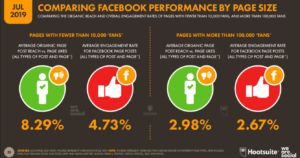What is your company’s social media strategy like? Social media is no longer a new thing, but it seems unknown to many companies to make a result there.
Social media has become one of the fundamental pillars of digital marketing, and without it companies cannot reach their true potential. Social media has its own place and role in digital marketing as a whole.
With a properly executed social media strategy, you can get two things right:
- Inform your company’s brand and services to completely new customers. This will act as the engine of your business’s growth.
- A higher percentage of people who know your company’s brand and service want to buy from you.
A well-executed social media strategy will tell you step by step how you can achieve those two benefits as quickly and cost-effectively as possible.
Paid vs. organic social media – visibility differences are large
No good thing in life comes for free, neither do good results on social media. It’s nice to dabble with organic posts and updates, but I can assure you that achieving cost-effective growth with “free” social media is almost impossible. Paid social media gives you a lot more than just more eye pairs for your boosted updates.
The figure below shows statistics from June 2019. An update (post) on your company’s Facebook page reaches an average of 2.08% to 8.29% of all people who liked your Facebook Page. From this, your internal math genius can quickly calculate that it doesn’t create a lot of sales.

source: Hootsuite
However, simply pouring in euros to boost upgrades does not yet solve this challenge. It’s a bit like trying to fire a shotgun at precision shooting range, in the dark, while blindfolded. There will be a lot of noise, but there will be no results.
This brings you to the simplified formula for success in marketing: show the right message to the right person at the right time. And this is what we can do with a social media strategy.
Social media strategy – the right message for the right person at the right time
Imagine you’ve been looking for a new car for yourself. You know which model you want and how much money you’re willing to pay for it. However, by googling, you haven’t found a suitable car yet. Suddenly you see an ad on Facebook about the car model you’re just looking for, and the price seems to be right. You click on the ad on the website, contact the seller and make a deal. This deal wouldn’t have happened if you (the right person) hadn’t seen just the right car (the right message) just when you were looking for one (right time).
Let’s take another example. You live in a house, it’s early July, the sun has been shining for a week straight, the weather is absolutely great. Sleeping starts to get challenging in that heat. After a poorly slept night (at the right time), while sipping your morning coffee, you scroll through your phone and answer an advertisement for an air conditioner (the right message) to cool the indoor air to suit you (the right person).
We could continue these examples until the end of the world. The same applies to any product or service purchased. There is no point in us advertising the wrong message to the wrong person at the wrong time. It’s just wasting your money and your time.
A well-done social media strategy tells you: to whom, what and when.
Social media strategy is built around buyer personality
We’re not talking about the kind of buyer personality you’ve seen all over the internet. We don’t care if someone who buys new financial management software has a dog, two kids, or does he do Pilates. We are interested in the things that really affect the purchasing process of this buyer persona, from start to finish.
In the first phase of a well-done buyer persona survey, we will find out who these buyer personalities are.
- Reading process is influenced by individuals, their roles and responsibilities.
- B2B stores, there are usually more people influencing the purchasing process. Each of these individuals is one buyer persona and each buyer persona has different responsibilities, motivations and interests.
- B2C stores, there are usually only one or at most a few people influencing the purchase process. If the service is sold to single-family houses, it can be assumed that both husband and wife.
Since the first stage, we have had a very good overview of who (the right people) are influencing the purchasing process. These are the buyer personalities. We then delve deeper into each buyer persona separately, where we find out at what point in the purchase process (at the right time) we need what kind of content (the right message).
Four factors affecting the purchase, which will be determined separately for each buyer person.
- start of the purchase process
- What happens to the buyer persona? They noticed a problem or had a dream.
- Marketing’s mission is either to make the customer indulge and feel the pain of having a problem, or marketing needs to make the customer think about the dream.
- the indicators of success
- How a customer expects their life to change when they buy your product or service. For example, saving money, saving time, feeling safe, having a fun experience, etc. This is not about the features of a product or service, but about how the features of a product or service change the customer’s life.
- Marketing’s mission is to make the customer a more understanding and feeling how much better their life will be after they have access to your product or service.
- Reading barriers
- Which potential customers have either failed to buy altogether or have purchased a similar service from a competitor. Barriers to purchase may include, for example, lack of funding, short warranty, lack of technical support after purchase, etc.
- the mission is to make the customer understand and feel that there are no barriers to buying or they are significantly smaller than they imagined.
- criteria for the purchase decision
- What are the metrics that a customer uses to compare your product with those of competitors. What are the indicators by which the customer evaluates the benefits they receive when purchasing your product or service.
- the mission is to make the customer notice the very features of your product or service that enable them to make a decision.
BONUS-1: The buyer persona interview often reveals things that have not previously been taken into account in the development of a product or service, but are important to the customer.
BONUS-2: Buyer personality research often also provides very valuable information about the development of sales tools and the development of sales processes.
Your salesperson to support the construction of your social media strategy
Your salespeople know your customers well. Your salespeople know what things your customers always ask at some point in the purchase process. They also know what customers don’t ask, but what they always needs to teach the customer so they can make a purchase decision.
It’s important that your sales team includes people to make a social media strategy. They may have more information about your company’s customers than anyone else. However, that’s not the only reason sales is included in the design of their social media strategy. Our goal is to increase sales.
If it’s not an online store, the salespeople are the ones that make those deals. For this reason, it is very important that social media marketing consistently generates high-quality leads for your sales that turn into a store. So we need to understand sales and sales need to understand marketing. Once these things are in order, the euros invested in social media marketing will be seen in sales numbers increasing.
Read more about what B2B-sales in 2020 means in digital marketing.
Social media competitor analysis shows competitors’ weaknesses and strengths
The social media strategy goes deep into detail in the digital marketing of your worst competitors. Yes, I deliberately wrote in digital marketing. Although our goal is to implement a social media strategy, it overlaps with many other aspects of digital marketing. Competitors’ website plays an important role in this.
The competitor analysis checks your competitors’ websites to see if they have installed the necessary analytics tools to measure advertising. Only with correctly installed analytics can we know how well our advertising actually works.
Your competitors’ websites will be subject to a content analysis. This analysis will see what kind of content your competitors have for each stage of the purchase process.
In addition to analyzing website analytics and content, it’s a good idea to analyze social media ads made by competitors. What kind of post, what kind of images, and what kind of videos your competitors have used in their paid social media ads. The ad analysis also shows where your competitors redirect potential customers from ads. For example, do they direct you directly to contact you or perhaps to informative blog content.
TIP-1: Facebook Ads Library is where you can spy on your competitors’ Facebook and Instagram ads
TIP-2: With the Facebook Pixel Helper plugin you can find out if your competitor has installed Facebook analytics and what conversions they’re measuring.
TIP-3: Google Tag Assistant , among other things, what Google analytics tools your competitors have installed on their website.
”During competitor analysis, we get a clear picture of how we can get ahead of our competitors.”
Content plan for social media strategy
The information collected during buyer personality research, interviewing salespeople and competitor analysis makes it easy to build an effective content plan.
The content plan clearly lists content for each buyer person at each stage of the purchase process. The listing uses both content that already exists in your company and new content to be produced.
The content plan for the social media strategy includes both text, charts, images, and videos. Some of this content is used directly in ads, some content is placed on your website, where customers are redirected from ads.
Once the content plan is implemented, we have the right message, at the right time, for the right person, for each buyer person. Thus, we can attract the interest of new customers and get them to pick up the handset and call you.
Read more about content production based on buyer personality: Acquiring leads through content marketing – buyer personality is at the heart of everything
Social media strategy action plan
Well planned is yet to be fully done. The curse of strategies is often that they sound and look good, cost a pile of money and are forgotten somewhere in the archives.
A good strategy always includes a clear action plan. A good strategy serves as a tool for efficient work, which can always be returned to and a new idea can be sought for doing.
A good action plan has appointed the responsible persons for each task. The tasks to be done in a good action plan are in order of priority.
A good action plan prioritizes quick profits right from the start. Once these “easy” profits are picked up, the focus will begin on longer-term results. This principle will generate returns on the euros invested in social media advertising as quickly as possible, without forgetting the objectives of long-term growth.
What’s your agenda like?
What are you going to do next to develop your digital marketing? Do you have a realistic and results-delivering plan for that? Do you know where you start making a strategy? Do you know how to target the right message to the right people at the right time? Is your message correct? Will your potential buyer light up from your message? Is the buyer interested in your product or service? Does your social media ad make your potential customer work?
If you want the fastest route to the results, please contact us. We will build you an action plan to achieve measurable results.
Contact us

